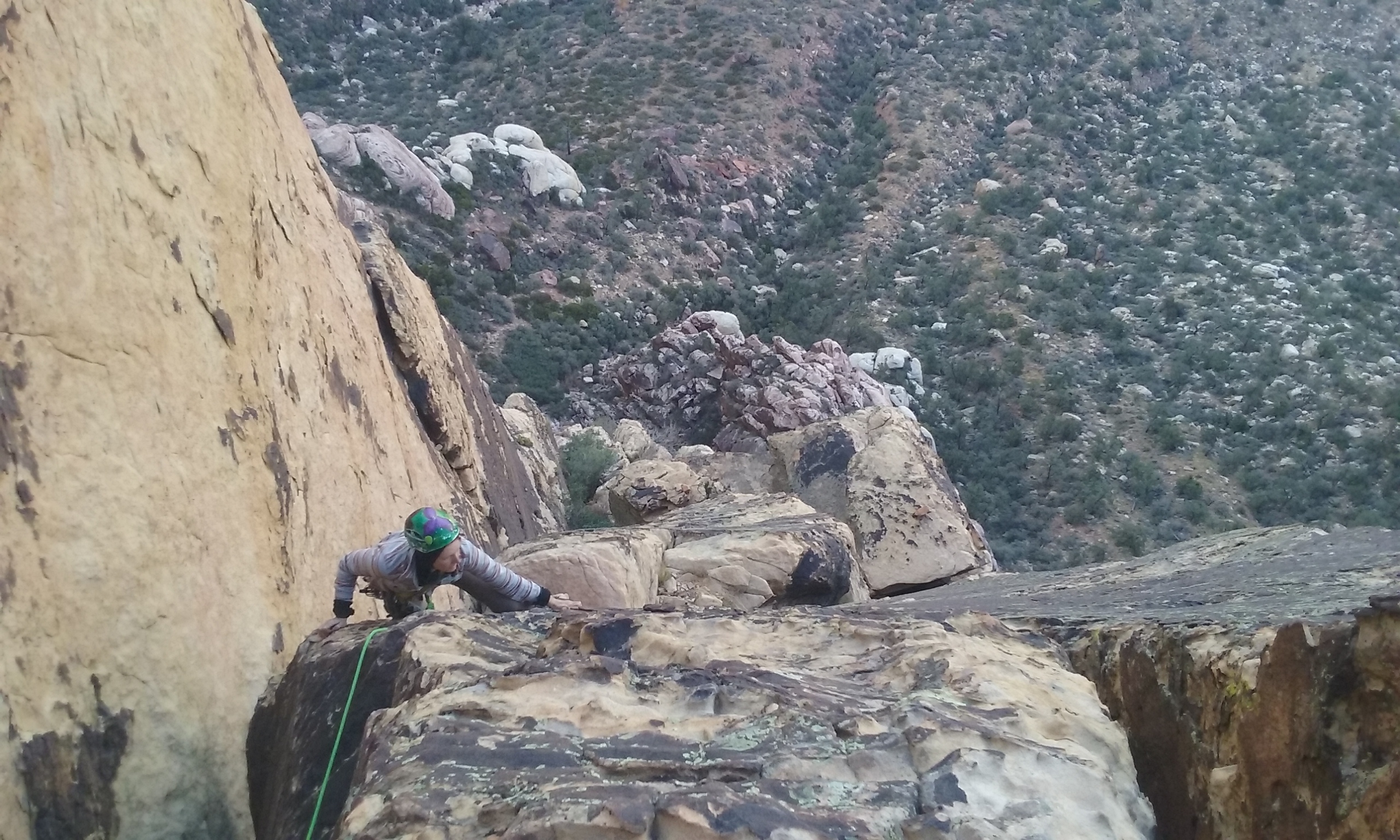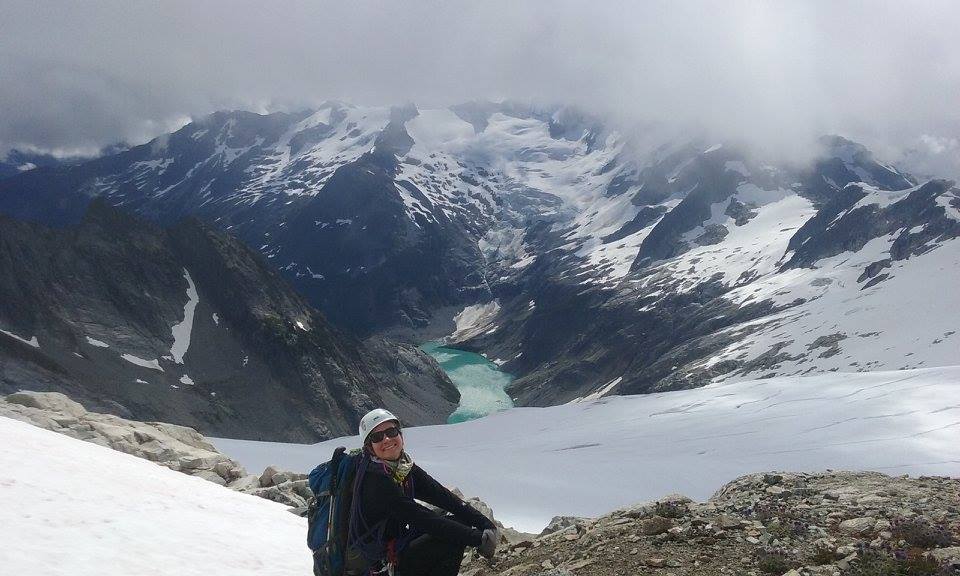She told me this as we arrived at the base of the pitch. She was right. I had talked up this splitter finger crack all morning and passed the heady, adventurous lead to her earlier that day. I had followed this climb the year before, put up by a male friend, and I had to come back for the lead. A single pitch, the crux is a .3” crack with no feet. It was definitely one that would push me, one that maybe I would try to top-rope again first if that was an option. But it was my lead. Climbing with Amber, I couldn’t just talk about climbing this pitch all morning then expect her to put it up for me. I racked up, she flaked out the rope, and I hopped on.
 |
| Laura after our FAFMPA, or "First-All-Female-Multi-Pitch-Ascent." |
“What happens when women climb together?”
A male climbing partner once asked this of another female friend. He was genuine in his curiosity, because he knew that there is something different, something special about it. What happened between me and Amber starts to get at the answer.
When I climb with women, I am held accountable to my own strength and abilities. When I climb with men, no matter how healthy our relationship, there is almost always the assumption that he will take a lead that scares me. This dynamic exists regardless of whether we are dating, just met, close friends, or of equal climbing ability. This dynamic even exists if I am a stronger climber than him, technically or physically. I’m using “him” in a universal sense here, because this so ubiquitous in my experience. It’s not necessarily an intentional dynamic on “his” part; many men I climb with encourage me to lead pitches and are great, supportive partners. I’m also sure that I perpetuate the dynamic when I accept the top-rope, but I didn’t create it.
Mountain guide and writer Charlotte Austin touched on this in her Alpinist article “Freedom in the Hills,” noting the confidence gap that exists between male and female climbers. “Girls are usually more sheltered and protected…rather than being prepared for independence, we learn to take a supporting role, which hinges upon reliance on others.” I feel this while climbing with men. I try to fight it, but it’s deep within. And between us.
 |
| Amber on the last pitch of Ginger Cracks in Red Rock Canyon |
When asked what motivates them to take the sharp end, climbers say many different things. They seek the “flow,” the intense focus of leading, the mind-body connection, the adrenaline, the feeling of being alive. Since I usually just get a stomach ache instead of an adrenaline rush, my motivation has been different. I have realized that for me, leading defines self sufficiency as a climber. If I can put up a climb, I can climb the routes that draw me, without depending on someone else’s abilities. Of course, I depend on a climbing partner to belay or swing leads, but it can be a mutual dependence, rather than a leader-follower relationship. “Many women seek all-women’s expeditions to remind themselves and others of the female’s capacity for climbing hard,” noted Molly Loomis in her 2005 article for the American Alpine Journal. When I am climbing with another woman, I go to my limit, I get on the sharp end, I get scared and try hard, every time.
 |
| Kel below Eldorado's East Ridge |
“Your hang-dogging is sexy as hell!”
She yelled this up at me, as I shook out my forearms and hung on my yellow cam. I first saw this climb last summer: three perfect corners against a sweeping granite wall. And it’s hard, with overhung wide hands, but I wanted to get on this climb badly enough that I would flail my way up it on lead. This may have been the last day of the season at Index for me, and it was a perfect fall day; carpets of orange leaves were hiding all of the trails, and Mt Index was dusted with snow. I made some hasty tape gloves while Tulin flaked out the rope for the first pitch, her lead. Before she went up, she told me, “I’m going to make an anchor with the rope and belay you up with a Gri-Gri, is that okay? I’ll also probably let you know to ‘watch me’ when I’m scared, even though you probably will be already watching me.” She let me know what she needed, then checked in with me again before I took over the lead on the next pitch.
 |
| Amber tossing ropes on Forbidden's West Ridge. |
“We didn’t have to be so careful with what we said to each other, and we made decisions by consensus.”*
That’s something else that happens when I climb with women, whether I’m at a sunny “Ladies Crag Day” in Red Rocks, projecting a plastic boulder problem inside with my co-workers, or kicking steps on a snowy alpine climb in the North Cascades. We ask questions, we seek consensus, we communicate. I admittedly have grumbled about the stereotypical “women’s climb nights,” where it seems you have to own sparkly tights to participate. But if that creates a space where women can learn and ask questions with confidence, bring on the tutus! (Or not! Express your gender however you want, am I right?!) Almost all of my technical climbing training has been in male-dominated spaces, and all of my climbing instructors have been men. Questions can feel stifled by ego, and competition replaces vulnerability. “Watching a man do something bears no significance to a women - it simply does not apply to her,” said Abby Watkins, a certified Canadian Mountain Guide. I feel the difference when women teach one another, whether informally in tights at a ladies crag day or at official women’s only events like the Women's Climbing Festival. There is a model to follow, a dialed woman demonstrating the hard skills, and the glass ceiling cracks just a little bit.
 |
| Ladies Crag Day at Red Rocks! |
So let’s all go climb together right away, and we’ll send all the things and have a super awesome time, right?! Why have I found it to be a little more complicated than that? For a while, I couldn’t find many women to climb with, and I ended up learning most of my climbing skills from men. There was a scarcity of women in my early climbing. This scarcity of female climbers and mentors creates another, more destructive dynamic that I’ve witnessed more recently. Women often feel the need to prove that they can "hang" or "keep up" to keep their spot in the "boys' club." Rather than women lifting one another up, the scarcity causes competition. I want us to start talking about this more, both men and women. And I want us to reconcile with how this happens outside of our climbing bubble, in other male-dominated industries, because this is not just a women's problem, and it's not just a climbing problem. How do we create spaces that gain from the unique talents that women or minority groups offer? Is it possible to make change within established industries, or must we create something new? Do the climbing community, engineering industry, or firefighter's unions care about this? It's about time to find out.
*From Molly Loomis's article "Going Manless," published in the 2005 American Alpine Journal "Going Manless"
--Katie Griffith, Instructor and Guide

No comments:
Post a Comment